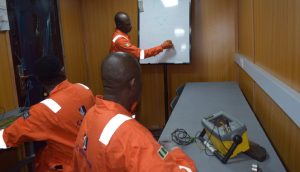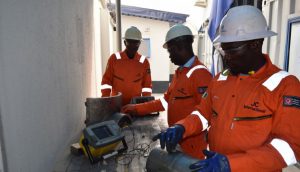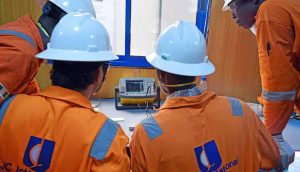
Objective
To gain experience with and understanding of the types, advantages and applications of various NDT methods.
- Foundation: To provide students with a strong knowledge of terms, concepts, principles etc. involved in Non-Destructive Testing.
- Skills: To provide practical training in handling and testing the Non-Destructive Testing equipments.
- Data Analysis: To develop knowledge and skills for interpretation and evaluation of the results.
- Awareness and professional Ethics: To offer environment to enhance team essential skills for effective careers in the inspection profession.
Course Details
Courses
Ultrasonic Testing Level I
Ultrasonic Testing Level II
UT TKY Qualification ( API-RP-2X)
Ultrasonic Thickness Gauging Level II
Magnetic Particle Testing Level I
Magnetic Particle Testing Level II
Liquid Penetrant Testing Level I
Liquid Penetrant Testing Level II
Duration
5 days
5 days
5 days
5 days
3 days
3 days
3 days
3 days
Dye Penetrant Inspection
Scientific Principles
Penetrant solution is applied to the surface of a precleaned component. The liquid is pulled in to surface breaking defects by capillary action. Excess penetrant material is carefully cleaned from the surface. A developer is applied to pull the trapped penetrant back to the surface where it is spread out and forms an indication. The indication is much easier to see than the actual defect.
Main Uses
Used to locate cracks, porosity and other defects that break the surface of a material and have enough volume to trap and hold the penetrant material. Liquid penetrant testing is used to inspect large areas very efficiently and will work on most nonporous materials.
Main Advantages
Large surface areas or large volumes of parts/materials can be inspected rapidly and at low cost.
Parts with complex geometry are routinely inspected.
Indications are produced directly on surface of the part providing a visual image of the discontinuity.
Equipment investment is minimal.
Disadvantages
Detects only surface breaking defects. Surface preparation is critical as contaminants can mask defects.
Requires a relatively smooth and nonporous surface.
Post cleaning is necessary to remove chemicals.
Requires multiple operations under controlled conditions.
Chemical handling precautions are necessary (toxicity, fire, waste).
Magnetic Particle Inspection
Scientific Principles
A magnetic field is established in a component made from ferromagnetic material. The magnetic lines of force travel through the material, and exit and reenter the material at the poles. Defects such as crack or voids cannot support as much flux, and force some of the flux outside of the part. Magnetic particles distributed over the component will be attracted to areas of flux leakage and produce a visible indication.
Main Uses
Used to inspect ferromagnetic materials (those that can be magnetized) for defects that result in a transition in the magnetic permeability of a material. Magnetic particle inspection can detect surface and near surface defects.
Main Advantages
Large surface areas of complex parts can be inspected rapidly.
Can detect surface and subsurface flaws.
Surface preparation is less critical than it is in penetrant inspection.
Magnetic particle indications are produced directly on the surface of the part and form an image of the discontinuity.
Equipment costs are relatively low.
Disadvantages
Only ferromagnetic materials can be inspected.
Proper alignment of magnetic field and defect is critical.
Large currents are needed for very large parts.
Requires relatively smooth surface.
Paint or other nonmagnetic coverings adversely affect sensitivity.
Demagnetization and post cleaning is usually necessary
Ultrasonic Inspection
Scientific Principles
High frequency sound waves are send into a material by use of a transducer. The sound waves travel through the material and received by the same transducer or a second transducer. The amount of energy transmitted or received and the time the energy is received are analyzed to determine the presence of flaws. Changes in material thickness and changes in material properties can also be measured.
Main Uses
Used to locate surface and subsurface defects in many materials including metals, plastics and wood. Ultrasonic inspection is also used to measure the thickness of materials and otherwise characterize properties of material based on sound velocity and attenuation measurements.
Main Advantages
Depth of penetration for flaw detection or measurement is superior to other methods.
Only single sided access is required.
Provides distance information.
Minimum part preparation is required.
Method can be used for much more than just flaw detection
Disadvantages
Surface must be accessible to probe and couplant.
Skill and training required is more extensive than other technique.
Surface finish and roughness can interfere with inspection.
Thin parts may be difficult to inspect.
Linear defects oriented parallel to the sound beam can go undetected.
Reference standards are often needed.
Target Audience
- Level I: NDT Operators, NDT Salesmen, Anyone seeking the Basic NDT Principles and Practices.
- Level II: Engineers & QA/QC Personnel, Welding Supervisors & Inspectors, NDT Technicians & Practitioners, Qualified NDT Level I individuals who want to be qualified as Level II.
Award
Delegates attending and successfully completing both the practical and written assessments will be awarded a certificate showing compliance with SNT – TC – 1A.



